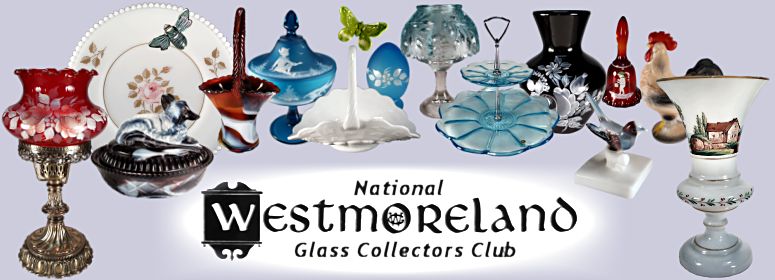WESTMORELAND GLASS HISTORY
In 1889 a group of investors took the risk of founding a glass company - it became the Westmoreland Glass Company of Grapeville, Pennsylvania and had a successful history that spanned nearly 100 years. These intrepid individuals did more than start a glass factory - they touched all our lives by giving us the beautiful handmade glassware we collect and cherish today.
Built in the rolling hills of Pennsylvania, there is speculation that the most probable reason for Mr. Stevenson purchasing the land at Grapeville Station was the abundance of natural gas on the property. Natural gas is a necessary element in glass manufacturing. Close proximity to the Pennsylvania railroad enabled him obtain raw materials easily, as well as to ship the finished product. With ample shade trees to cool the grounds, and a supply of pure spring water, the ideal spot had been found.
As an incentive to move employees and their families to the site of the new plant at Grapeville Station, the acreage was divided into 105 lots. Free gas would be furnished at no cost for lighting and heating as long as the supply would last, estimated to be 20 years.
As people began relocating to the area, the construction of the plant got under way in October of 1889. The first glass was produced in 1890.
few years later, the plant was purchased by two brothers, Charles H. and George West, from A. J. Stevenson and the Specialty Glass Company. Financial support was provided by Ira A. Brainard. Westmoreland Specialty Company changed hands again when in 1920 tension between brothers arose and George West sold his interest to Charles West and Ira Brainard. In 1923 the name was changed to Westmoreland Glass Company. The great depression forced Charles West to sell his interest to the Brainard family, who reorganized the company with James J. Brainard as president. After his death in 1953, his son James H. Brainard succeeded him, with his brother Walter M. Brainard taking the position of vice president. In 1981 ownership was purchased by Dave Grossman. On May 21, 1984 the flame at the Westmoreland Glass Company was finally extinguished. A lifespan of nearly a few years short of a century had ended.
The following is a letter by J. H. Brainard, President of Westmoreland Glass:
Historical Sketch of Westmoreland Glass Company
A copy of the earliest record is herewith enclosed, and it indicates that in the Spring of 1889 a group of men operating the Specialty Glass Company in East Liverpool, Ohio, migrated to Grapeville because of Gas being on the property where our plant is now located. In October of 1889 construction of the plant started and actual production occurred in early 1890.
My Grandfather, Ira A. Brainard, lived in Pittsburgh--about 25 miles west of Grapeville, and had many interests and was instrumental in financially helping two sons, with a widowed mother, participate in the development of the factory here at Grapeville. The men from East Liverpool sold out their interest in the very early 90's and the two West brothers, backed by my grandfather's finances operated the plant successfully until 1920. At that time, friction developed between the West brothers, and one sold his interest to the other and my grandfather.
In 1924, it was voted to change our name from Westmoreland Specialty Company to WESTMORELAND GLASS COMPANY, as the former had become somewhat of a misnomer because they began to get inquiries on many different types of products, going so far as Flat Silverware for use in the Railroad's Pullman Dining Cars. I believe that even a request was made for Guns during World War I. By that time, people began to feel that we manufactured most any item. Actually, glassware was the only real item manufactured, although early in the l900's many condiments, such as vinegar, mustard, baking powder, lemon flavor, etc. were processed here, but it is difficult to say whether such things were supplied in the containers for the purpose of selling the glassware or the condiment involved.
During World War I many glass items contained candy and were distributed by the News Stands and Dime stores throughout the country. Such diversification was not profitable because, as mentioned above, glass was the primary product of the Company. It was of high quality, manufactured by hand from the Pot Furnaces. Milk Glass, such as our Hens and other pieces illustrated in the current catalog, was probably the outstanding material produced, although in the 1920's we did make some high quality decorated ware and crystal. We still manufacture some decorated ware in addition to Colored Crystal such as Amber, Blue, Green, Pink and Brown. During the last thirty years, our manufacturing has been 90% Milk Glass, and the quality today is undoubtedly superior to that of years ago.
In the years following the Civil War, there were a number of Milk Glass producers in the Pittsburgh, Pennsylvania area, and one of the outstanding plants was the Atterbury Company. They made high quality Milk Glass and our company came into it a year or so after they went out of existence. So, in a sense, we carried on where they left off.
During the depression in the 30's, our Company like many plants, was badly hurt, but we never stopped operations and re-organization took place in 1937 after the West financial interest became worthless and considerable investment was being risked by the Brainard interest. My father, James J. Brainard, who joined the Company in 1920 as treasurer, became President in 1937. I took over as treasurer after joining the Company in 1933 following graduation from Yale University.
My father's death occurred in 1953, and I became President of the Company shortly afterwards. My grandfather died in 1927.
J. H. Brainard, President
NEWS & EVENTS
GALLERY
MEMBERSHIP
HAVE A QUESTION?
Email us and we will respond as soon as possible.

